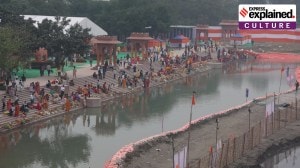Turbulence over the head gear
Turbans,that symbol of Afghan identity,is subject to search after the suicide attack on Burhanuddin Rabbani. The searches are deeply disturbing,say Afghan men
ALISSA J RUBIN
Straight-backed,his bearing almost regal,Malik Niaz,82,entered the Afghan presidents compound this month,proudly wearing his best turban: a silk one from Turkestan,gray and black and white,its long tail draped gracefully over his shoulder
He watched in disbelief as the guard asked the elder ahead of him to remove his turban and lay it on the table. Niaz,who had journeyed more than eight hours on rugged roads,shuddered. That made us so embarrassed,and it made me so sad, he said. I felt dishonoured when the guard said, he hesitated,as if even recalling the words made him upset,undo your turban.
I had wanted to see the president, he added,but after that search,I thought it would have been better if I had not come.
The turban-searching rule at President Hamid Karzais presidential palace has been rigorously enforced since the assassination of the head of Afghanistans peace process,Burhanuddin Rabbani,who was killed by a bomb hidden in the attackers turban. It was the third such killing in four months,leading youths in Kabul to coin the word Turbanator and American soldiers to invent the new acronym TBIED,for turban-borne improvised explosive device.
The other two instances were the killing in July of Kandahars senior cleric as he prayed in a mosque,and a few weeks later the killing of Kandahars mayor.
The searches are deeply disturbing for most Afghan men,as the turban here at once signifies ones religious faith and is a national dressnot to mention being something of a fashion statement.
Turbans are worn across the Muslim world because the Prophet Muhammad was believed to have worn one. In Afghanistan,which is a deeply pious country,usage is broader,with dozens of styles and colours. There are ones made of synthetics from Pakistan that cost about $20,silk ones from Herat that cost twice as much and ones made of more luxuriant silks from the north of Afghanistan that cost still more. The Taliban were known for wearing turbans made of a very soft cotton that had especially long tails and were either black or white; the former signifies that the wearers family members are descendants of Muhammad. However,most turbans in Afghanistan are subtle grays and charcoals,deep olive greens,lighter soft greens and browns.
I have four or five turbans, said Hajji Mohammad Zaman Ahmadi,a 57-year-old Kabul resident. He had just gotten a miniature turban for his two-year-old nephew,he said. It is made of the softest of our countrys wool, he said.
Many turban wearers are so angry about the current turban situation that they blame the Americans. Before their arrival,intrusive searches were unknown.
My father,my grandfather,my great-grandfather,my prophet wore a turban,and thats why I wear it, said an older man,adding: Who brought these turban bombers and turban searchers? You did, he said angrily,referring to Westerners,which many Afghans feel are agents of the decline of the society.
Many clerics take a more contemplative view. Faith transcends costume,and a man can pray in any outfit as long as the prayer comes from the heart,but it is an honour to God to dress properly,said Abdul Raouf Nafee,the mullah at the Herati mosque in central Kabul.
As an example,he talked about butchers: Even if their clothes are dirty with blood,they can pray and God will accept their prayers, Nafee said. He views the turban as a link between the holy life and peoples physical needs.
The turban,like the traditional shawl worn by men and the chador worn by women,is practical as well as religious and cultural,he said. You are covered to keep off the dustand now the pollution, he said. If you are cold,you can wrap it around you for warmth,you can sit on it,you can use it to tie an animal,a sheep or a goat,and you can use the turbans cap to carry water.
There is also a darker view of turban attacks: that the bombers were so distraught that their turbans holiness no longer mattered,and that they were forced to use any means available to take revenge on the Americans.
Is it wrong to respond to the killings of the civilians that you do with your drones,that shoot from the air and do not even have pilots? asked Hajji Ahmad Farid,a mullah and a conservative member of Parliament from an insurgent-dominated area of Kapisa Province,near Kabul. When a man has lost his dignity,he does not care about his shawl or his turban.



- 01
- 02
- 03
- 04
- 05




























